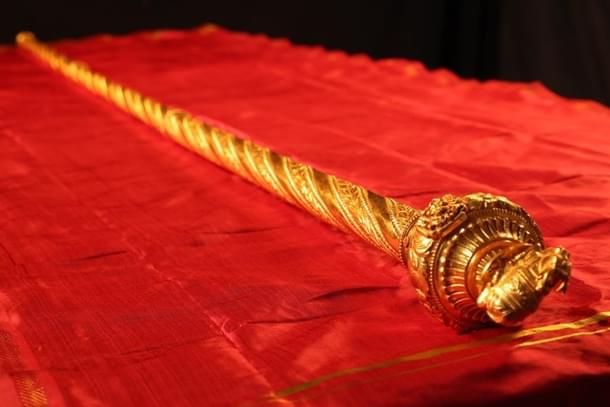Newsletters
@Evening: 🙏 What The Historical Symbol 'Sengol', A Proud Part Of New Parliament Launch, Symbolises
Karan Kamble
May 25, 2023, 08:55 PM | Updated 08:55 PM IST
Save & read from anywhere!
Bookmark stories for easy access on any device or the Swarajya app.
🫡 Paying homage to ancient tradition

India will witness the inauguration of the new Parliament Complex in Delhi this Sunday. The headlining act is the 'Sengol', loosely translated as a sceptre, from 1947.
Context: PM Narendra Modi will receive the precious Sengol during the inauguration of the complex, after which it will forever adorn the walls of this new Parliament.
What's a Sengol? The one that would feature in the new Parliament was made in 1947 and used during the ritualistic transfer of power from the British to the first prime minister of India, Jawaharlal Nehru.
But well, well before, a Sengol was used for the transfer of seat of power from one king to another by the rajguru (state priest).
The word "Sengol" derives from the Tamil word "semmai," indicating righteousness and symbolising power and justice.
During the Chola empire, the Sengol served as a ceremonial spear or flagstaff with elaborate carvings and intricate decorative elements.
It was considered a sacred emblem of authority, representing the transfer of power from one ruler to the next.
Over time, it emerged as an iconic symbol of Chola power.
The Sengol as a symbol. It symbolises that Dharma reigns over temporal power, Aravindan Neelakandan writes for Swarajya.
The purpose of the Sengol is to protect Dharma and Truth, he adds.
The great Tamil sage Thiruvalluvar states as much in Thirukkural.
He dedicated an entire chapter for what he calls Senkonmai, which means it is the Sengol which characterises good governance.
The bull at the top of the (1947) Sengol is the bull of Dharma.
In sacred Indian literature, Dharma is symbolised by a bull, also the all-pervading form of Vishnu. (Read Neelakandan's article for more.)
The Sengol and Indian Independence. Before the transfer of power on 15 August 1947, Lord Mountbatten reportedly enquired about the ritualistic manner of transfer of power or an appropriate ceremony for it.
Nehru consulted with statesman C Rajagopalachari (Rajaji), who recommended taking a cue from the Chola dynasty’s model of power transfer.
In that old tradition, the transition from one king to another was sanctified and blessed by high priests, with the handing over of the ceremonial flagstaff, the Sengol.
Rajaji approached the Thiruvavaduthurai Adheenam, a Dharmic Mutt located in the Thanjavur district of Tamil Nadu, for their assistance in the making of a Sengol.
And thus it came to be, and served as a symbol at a critical moment in modern Indian history.
Unfortunately, it was not assigned a significant place thereafter, being relegated to a museum in Anand Bhavan in Prayagraj (previously Allahabad).
New India restores Dharma. The move to re-enact the ritual as PM Modi inaugurates the new Parliament is a testament and tribute to an ancient tradition which previously launched modern India on its independent journey.
Once again it is called on as India celebrates 75 years of independence with Azadi Ka Amrit Mahotsav.





